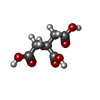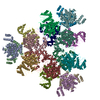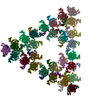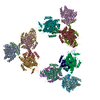+Search query
-Structure paper
| Title | Emergence of fractal geometries in the evolution of a metabolic enzyme. |
|---|---|
| Journal, issue, pages | Nature, Vol. 628, Issue 8009, Page 894-900, Year 2024 |
| Publish date | Apr 10, 2024 |
 Authors Authors | Franziska L Sendker / Yat Kei Lo / Thomas Heimerl / Stefan Bohn / Louise J Persson / Christopher-Nils Mais / Wiktoria Sadowska / Nicole Paczia / Eva Nußbaum / María Del Carmen Sánchez Olmos / Karl Forchhammer / Daniel Schindler / Tobias J Erb / Justin L P Benesch / Erik G Marklund / Gert Bange / Jan M Schuller / Georg K A Hochberg /    |
| PubMed Abstract | Fractals are patterns that are self-similar across multiple length-scales. Macroscopic fractals are common in nature; however, so far, molecular assembly into fractals is restricted to synthetic ...Fractals are patterns that are self-similar across multiple length-scales. Macroscopic fractals are common in nature; however, so far, molecular assembly into fractals is restricted to synthetic systems. Here we report the discovery of a natural protein, citrate synthase from the cyanobacterium Synechococcus elongatus, which self-assembles into Sierpiński triangles. Using cryo-electron microscopy, we reveal how the fractal assembles from a hexameric building block. Although different stimuli modulate the formation of fractal complexes and these complexes can regulate the enzymatic activity of citrate synthase in vitro, the fractal may not serve a physiological function in vivo. We use ancestral sequence reconstruction to retrace how the citrate synthase fractal evolved from non-fractal precursors, and the results suggest it may have emerged as a harmless evolutionary accident. Our findings expand the space of possible protein complexes and demonstrate that intricate and regulatable assemblies can evolve in a single substitution. |
 External links External links |  Nature / Nature /  PubMed:38600380 / PubMed:38600380 /  PubMed Central PubMed Central |
| Methods | EM (single particle) / X-ray diffraction |
| Resolution | 2.71 - 5.91 Å |
| Structure data | EMDB-15529, PDB-8an1: EMDB-16004, PDB-8bei: EMDB-19250, PDB-8rjk: EMDB-19251, PDB-8rjl:  PDB-8bp7: |
| Chemicals |  ChemComp-SO4:  ChemComp-CIT:  ChemComp-MG:  ChemComp-HOH: |
| Source |
|
 Keywords Keywords | TRANSFERASE / Fractal complex / Krebs-cycle / TCA-cycle / szierpinski triangle |
 Movie
Movie Controller
Controller Structure viewers
Structure viewers About Yorodumi Papers
About Yorodumi Papers











 synechococcus elongatus pcc 7942 = fachb-805 (bacteria)
synechococcus elongatus pcc 7942 = fachb-805 (bacteria)